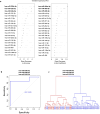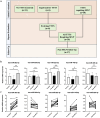Maternal plasma microRNA profiles in twin-twin transfusion syndrome and normal monochorionic twin pregnancies
- PMID: 40771891
- PMCID: PMC12325072
- DOI: 10.3389/fmolb.2025.1597215
Maternal plasma microRNA profiles in twin-twin transfusion syndrome and normal monochorionic twin pregnancies
Abstract
Introduction: Ultrasound-based staging systems for twin-twin transfusion syndrome (TTTS) are limited by radiologic expertise, fetal positioning, and timing of the exam, and may benefit from incorporation of objective biochemical measures for diagnosis and prognostication. microRNA expression is altered in amniotic fluid of TTTS patients, however the invasive nature of amniocentesis has precluded practical incorporation of these biomarkers into current staging systems. Therefore, we sought to assess whether non-invasive maternal plasma microRNAs can distinguish between TTTS and normal monochorionic diamniotic (MCDA) twin pregnancies.
Methods: Maternal blood samples were collected for patients with normal MCDA twin pregnancies (n = 11) or prior to selective fetoscopic laser photocoagulation (SFLP) for patients with TTTS (n = 36). Extracted microRNA from a panel of 24 microRNAs was compared between groups.
Results: miR-26a-5p (P = 0.004), miR-222-3p (P = 0.007), and miR-145-5p (P = 0.047) were downregulated and miR-320a-3p (P = 0.005) was upregulated in the maternal plasma of TTTS patients compared to controls. miR-26a-5p, miR-320a-3p, and miR-222-3p in combination were strong predictors of TTTS on random forest modeling (area under curve = 0.905). After SFLP, all significantly dysregulated microRNAs in TTTS trended toward levels of expression observed in control MCDA twin pregnancies.
Conclusion: Several microRNAs are differentially expressed in maternal plasma and demonstrate strong predictive capacity for identifying twin-twin transfusion syndrome. These plasma microRNAs could provide minimally invasive means to enhance currently established ultrasound diagnostic criteria for twin-twin transfusion syndrome.
Keywords: circulating biomarker; microRNA; monochorionic diamniotic pregnancy; pregnancy; twin-twin transfusion syndrome.
Copyright © 2025 Papastefan, Langereis, Redden, Liesman, Huerta, Turner, Kang, Stetson, Ott, Marriott, Ito, Shaaban and Alhajjat.
Conflict of interest statement
The authors declare that the research was conducted in the absence of any commercial or financial relationships that could be construed as a potential conflict of interest.
Figures




References
-
- Benjamini Y., Hochberg Y. (1995). Controlling the false discovery rate - a practical and powerful approach to multiple testing. J. R. Stat. Soc. Ser. B-Statistical Methodol. 57 (1), 289–300. 10.1111/j.2517-6161.1995.tb02031.x - DOI
LinkOut - more resources
Full Text Sources

